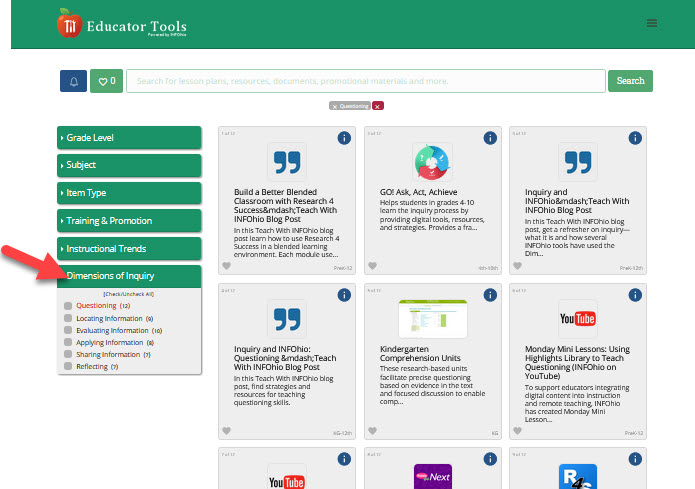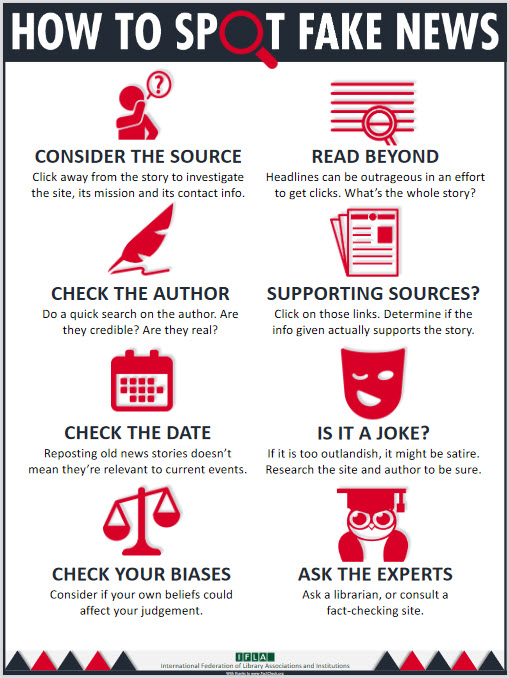The steps of information literacy can be applied to guide your students through the process of locating resources that are reliable and relevant to the course of study. The inquiry framework leads learners through the steps they should take when seeking out new information. To learn more about how the steps of inquiry affect learning new information, read this article discussing student-centered teaching. This instructional approach elevates student desire to inquire about new information.
As a librarian, you will want to understand how to encourage and assist your students through the process of inquiry. INFOhio's Dimensions of Inquiry was designed to support students and teachers through the inquiry process. As a student-centered approach to learning, the inquiry process is how students construct meaning and arrive at new understandings. INFOhio's model of inquiry is unique in that the process is neither linear nor cyclical. INFOhio takes a real-world approach to inquiry, understanding that all of the "dimensions" of inquiry can happen at any time throughout the learning process and may be repeated. The different dimensions that comprise INFOhio's inquiry model lay the foundation for many INFOhio tools created for student learning. The steps in INFOhio's Dimensions of Inquiry include:
On the INFOhio site, Educator Tools has the Dimensions of Inquiry as a limiter. This resource can be used to search for topics to expand and/or improve your knowledge of the steps in the Dimensions of Inquiry.

As students begin inquiry, they will need to know the importance of developing questions that provide a precise, deep dive into a specific topic. You can assist students by providing a foundation for good questioning techniques. For example, model asking questions with more than one answer to start class discussions. Review the article Essential Questions to learn more about developing questions to increase your students' inquiry on specific topics. INFOhio provides resources to encourage the growth of good questioning skills. Review the resources listed below to increase your knowledge and determine how you may incorporate them to increase student learning.
Read the following article to learn Five Ways to Strengthen Student Questioning to increase students questioning skills.
Once students have improved their questioning skills, it is time to locate reliable and relevant resources to answer the questions they have crafted. Resources on the library shelves library are one option for reliable information. However, teaching students to find reliable, relevant information online can be a little more complicated. Resources to begin to help students identify trustworthy information are:
Determining legitimate information online can be confusing. Read the Edmentum blog 5 tips for Helping Students of All Ages Find Credible Online Sources.
Knowing the difference between real news and fake news is becoming increasingly difficult, especially on social media. Providing students with valuable skills to effectively evaluate resources is an important step in the Dimensions of Inquiry. The following resources can be used as a guide to assist your students with evaluating resources:
Another resource to assist students with evaluating resources is the GO! Ask, Act, Achieve: How do I evaluate my sources? Teacher Guide. Having a visual representation and examples of what to look for will not only be helpful to your students, but may also be helpful in assisting you with what to look for when evaluating online resources. The video below uses the TRAAP (Timeliness, Relevance, Accuracy, Author, and Purpose) model to evaluate online resources.
;When students are searching for resources, it is a good idea to provide them with a handout on finding reliable resources. Download How to Spot Fake News by the International Federation of Library Association and Institutions. This infographic lists eight steps to use when evaluating online resources.

After students have found relevant, reliable resources, they will need to know how to use the resources to complete the assignment or project. Students will need to determine what resources will be needed for the assignment or project and which ones can be left out. They will also need to organize their resources and correctly cite sources to avoid plagiarism. Listed below are INFOhio resources that can be used by your students to guide them through this process.
Read the article Top 10 Reasons Students Plagiarize and What Teachers Can Do About It to learn how to help students steer clear of citation mistakes. Additional resources students can use to ensure they are properly citing their resources include Citation Machine and the Purdue Online Writing Lab.
Once students have learned to create effective questions and locate relevant resources, they will be able to share what they have learned. Students learn best when they are able to communicate with their peers, so creating an environment that encourages communication is the key.
INFOhio has a variety of resources students can use to learn about sharing with other students. Some of those resources include:
Students can share their works through Think-Share-Pair groups. Check out this article on alternatives to think-share-pair for tips to support students sharing what they know.
Questioning, Locating, Evaluating, Applying, Sharing, and Reflecting are all steps of INFOhio's Dimensions of Inquiry which allow students to be lifelong learners.
Reflecting on Your Learning
Answer the following questions in the INFOhio School Library Basics Open Space group Discussions. Find the Inquiry Framework reflection question in the Discussions tab. Reply to the thread and review other participants' responses.
Fetch is avaiable to INFOhio automated schools. If you are an INFOhio school, please log in with your school username/password using the button at the top-left corner of this page.
For more information about Fetch, please visit the Fetch information page or contact INFOhio support at https://support.infohio.org.